Strategic Project Delivery Report: Insights and Evaluation
VerifiedAdded on 2020/05/11
|12
|3193
|99
Report
AI Summary
This report delves into the realm of strategic project delivery, emphasizing project portfolio management and the competencies of program managers. The author analyzes four key articles, exploring topics such as competency models for program managers, the impact of management involvement on project portfolio management performance, measuring program success, and the role of project portfolio management in fostering deliberate and emergent strategies. The report highlights the importance of aligning projects with organizational strategy, the evolving role of project portfolio managers, and the critical factors influencing program success. The analysis provides insights into the complexities of managing projects, the need for adaptability in dynamic environments, and the significance of effective communication, leadership, and risk management. The author reflects on how these insights will inform their future role as a project portfolio manager and contribute to their academic pursuits, demonstrating a comprehensive understanding of the subject matter.
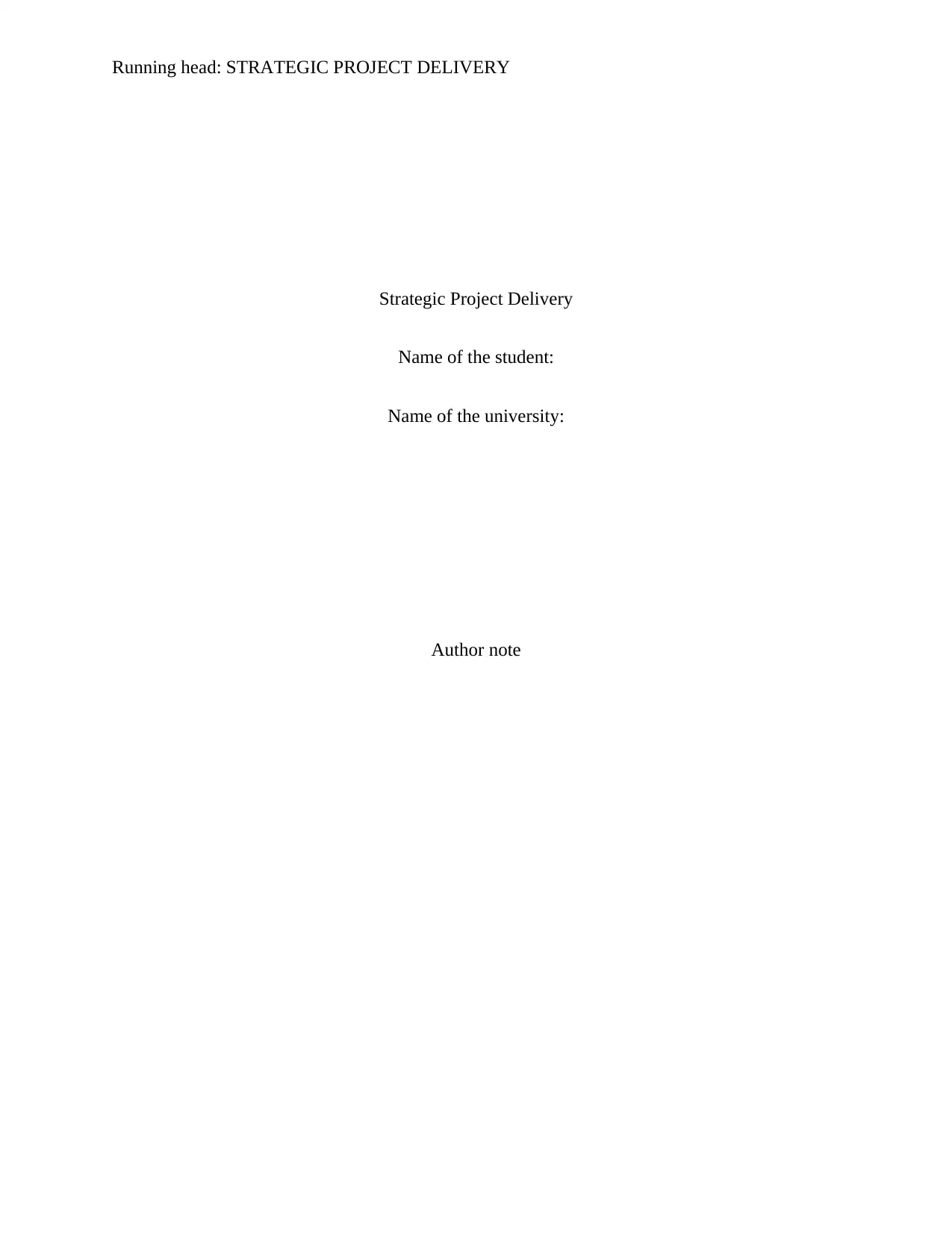
Running head: STRATEGIC PROJECT DELIVERY
Strategic Project Delivery
Name of the student:
Name of the university:
Author note
Strategic Project Delivery
Name of the student:
Name of the university:
Author note
Paraphrase This Document
Need a fresh take? Get an instant paraphrase of this document with our AI Paraphraser
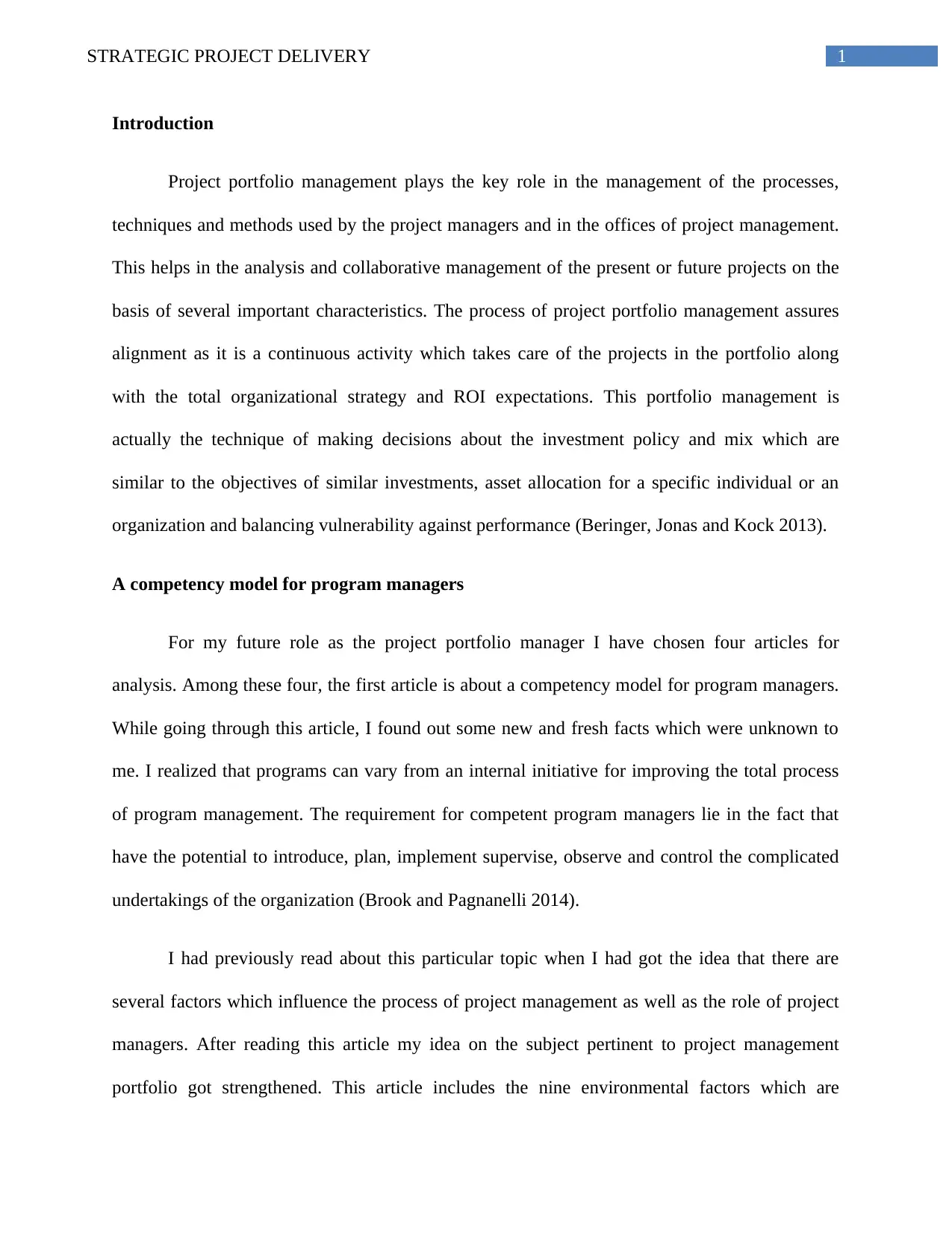
1STRATEGIC PROJECT DELIVERY
Introduction
Project portfolio management plays the key role in the management of the processes,
techniques and methods used by the project managers and in the offices of project management.
This helps in the analysis and collaborative management of the present or future projects on the
basis of several important characteristics. The process of project portfolio management assures
alignment as it is a continuous activity which takes care of the projects in the portfolio along
with the total organizational strategy and ROI expectations. This portfolio management is
actually the technique of making decisions about the investment policy and mix which are
similar to the objectives of similar investments, asset allocation for a specific individual or an
organization and balancing vulnerability against performance (Beringer, Jonas and Kock 2013).
A competency model for program managers
For my future role as the project portfolio manager I have chosen four articles for
analysis. Among these four, the first article is about a competency model for program managers.
While going through this article, I found out some new and fresh facts which were unknown to
me. I realized that programs can vary from an internal initiative for improving the total process
of program management. The requirement for competent program managers lie in the fact that
have the potential to introduce, plan, implement supervise, observe and control the complicated
undertakings of the organization (Brook and Pagnanelli 2014).
I had previously read about this particular topic when I had got the idea that there are
several factors which influence the process of project management as well as the role of project
managers. After reading this article my idea on the subject pertinent to project management
portfolio got strengthened. This article includes the nine environmental factors which are
Introduction
Project portfolio management plays the key role in the management of the processes,
techniques and methods used by the project managers and in the offices of project management.
This helps in the analysis and collaborative management of the present or future projects on the
basis of several important characteristics. The process of project portfolio management assures
alignment as it is a continuous activity which takes care of the projects in the portfolio along
with the total organizational strategy and ROI expectations. This portfolio management is
actually the technique of making decisions about the investment policy and mix which are
similar to the objectives of similar investments, asset allocation for a specific individual or an
organization and balancing vulnerability against performance (Beringer, Jonas and Kock 2013).
A competency model for program managers
For my future role as the project portfolio manager I have chosen four articles for
analysis. Among these four, the first article is about a competency model for program managers.
While going through this article, I found out some new and fresh facts which were unknown to
me. I realized that programs can vary from an internal initiative for improving the total process
of program management. The requirement for competent program managers lie in the fact that
have the potential to introduce, plan, implement supervise, observe and control the complicated
undertakings of the organization (Brook and Pagnanelli 2014).
I had previously read about this particular topic when I had got the idea that there are
several factors which influence the process of project management as well as the role of project
managers. After reading this article my idea on the subject pertinent to project management
portfolio got strengthened. This article includes the nine environmental factors which are
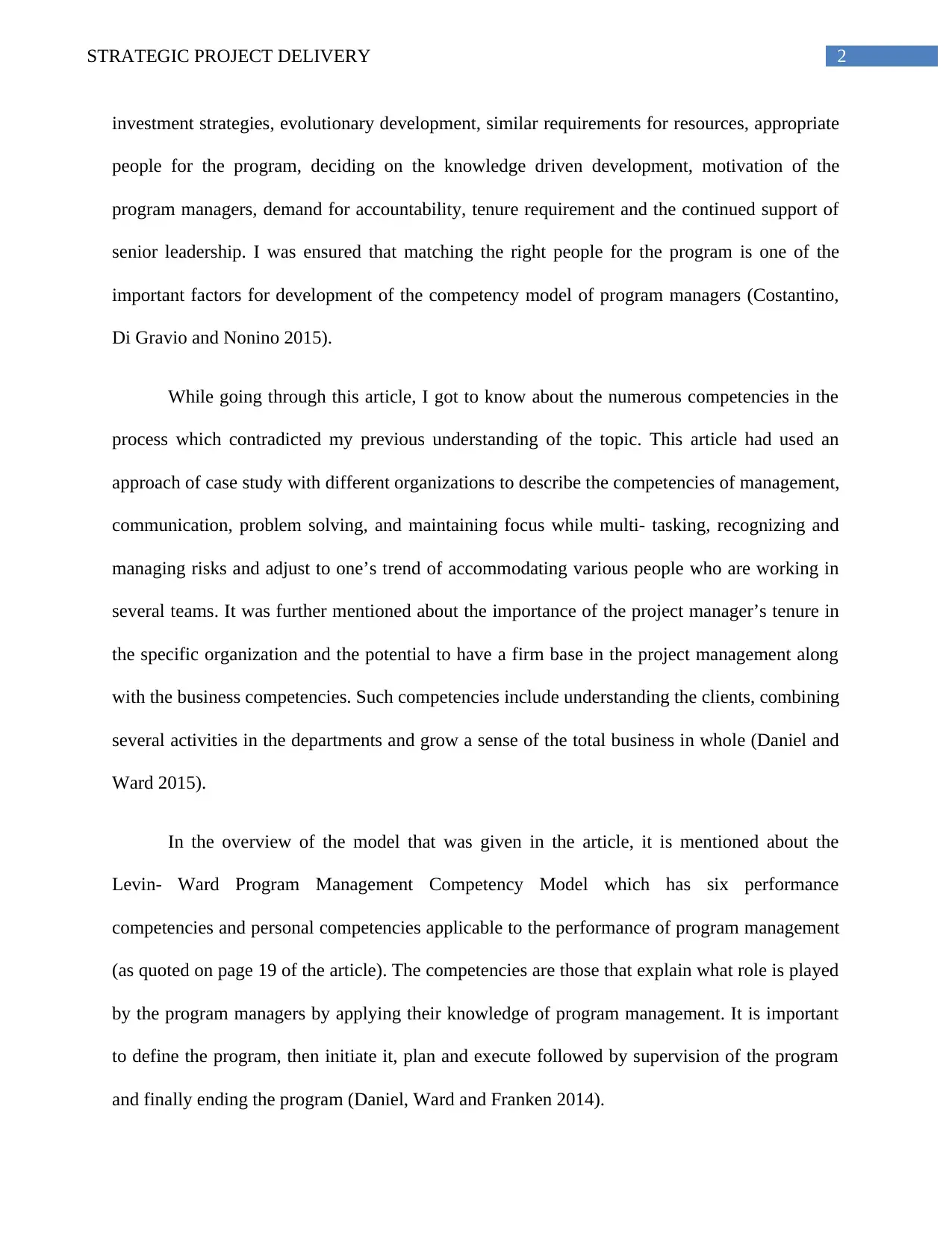
2STRATEGIC PROJECT DELIVERY
investment strategies, evolutionary development, similar requirements for resources, appropriate
people for the program, deciding on the knowledge driven development, motivation of the
program managers, demand for accountability, tenure requirement and the continued support of
senior leadership. I was ensured that matching the right people for the program is one of the
important factors for development of the competency model of program managers (Costantino,
Di Gravio and Nonino 2015).
While going through this article, I got to know about the numerous competencies in the
process which contradicted my previous understanding of the topic. This article had used an
approach of case study with different organizations to describe the competencies of management,
communication, problem solving, and maintaining focus while multi- tasking, recognizing and
managing risks and adjust to one’s trend of accommodating various people who are working in
several teams. It was further mentioned about the importance of the project manager’s tenure in
the specific organization and the potential to have a firm base in the project management along
with the business competencies. Such competencies include understanding the clients, combining
several activities in the departments and grow a sense of the total business in whole (Daniel and
Ward 2015).
In the overview of the model that was given in the article, it is mentioned about the
Levin- Ward Program Management Competency Model which has six performance
competencies and personal competencies applicable to the performance of program management
(as quoted on page 19 of the article). The competencies are those that explain what role is played
by the program managers by applying their knowledge of program management. It is important
to define the program, then initiate it, plan and execute followed by supervision of the program
and finally ending the program (Daniel, Ward and Franken 2014).
investment strategies, evolutionary development, similar requirements for resources, appropriate
people for the program, deciding on the knowledge driven development, motivation of the
program managers, demand for accountability, tenure requirement and the continued support of
senior leadership. I was ensured that matching the right people for the program is one of the
important factors for development of the competency model of program managers (Costantino,
Di Gravio and Nonino 2015).
While going through this article, I got to know about the numerous competencies in the
process which contradicted my previous understanding of the topic. This article had used an
approach of case study with different organizations to describe the competencies of management,
communication, problem solving, and maintaining focus while multi- tasking, recognizing and
managing risks and adjust to one’s trend of accommodating various people who are working in
several teams. It was further mentioned about the importance of the project manager’s tenure in
the specific organization and the potential to have a firm base in the project management along
with the business competencies. Such competencies include understanding the clients, combining
several activities in the departments and grow a sense of the total business in whole (Daniel and
Ward 2015).
In the overview of the model that was given in the article, it is mentioned about the
Levin- Ward Program Management Competency Model which has six performance
competencies and personal competencies applicable to the performance of program management
(as quoted on page 19 of the article). The competencies are those that explain what role is played
by the program managers by applying their knowledge of program management. It is important
to define the program, then initiate it, plan and execute followed by supervision of the program
and finally ending the program (Daniel, Ward and Franken 2014).
⊘ This is a preview!⊘
Do you want full access?
Subscribe today to unlock all pages.

Trusted by 1+ million students worldwide
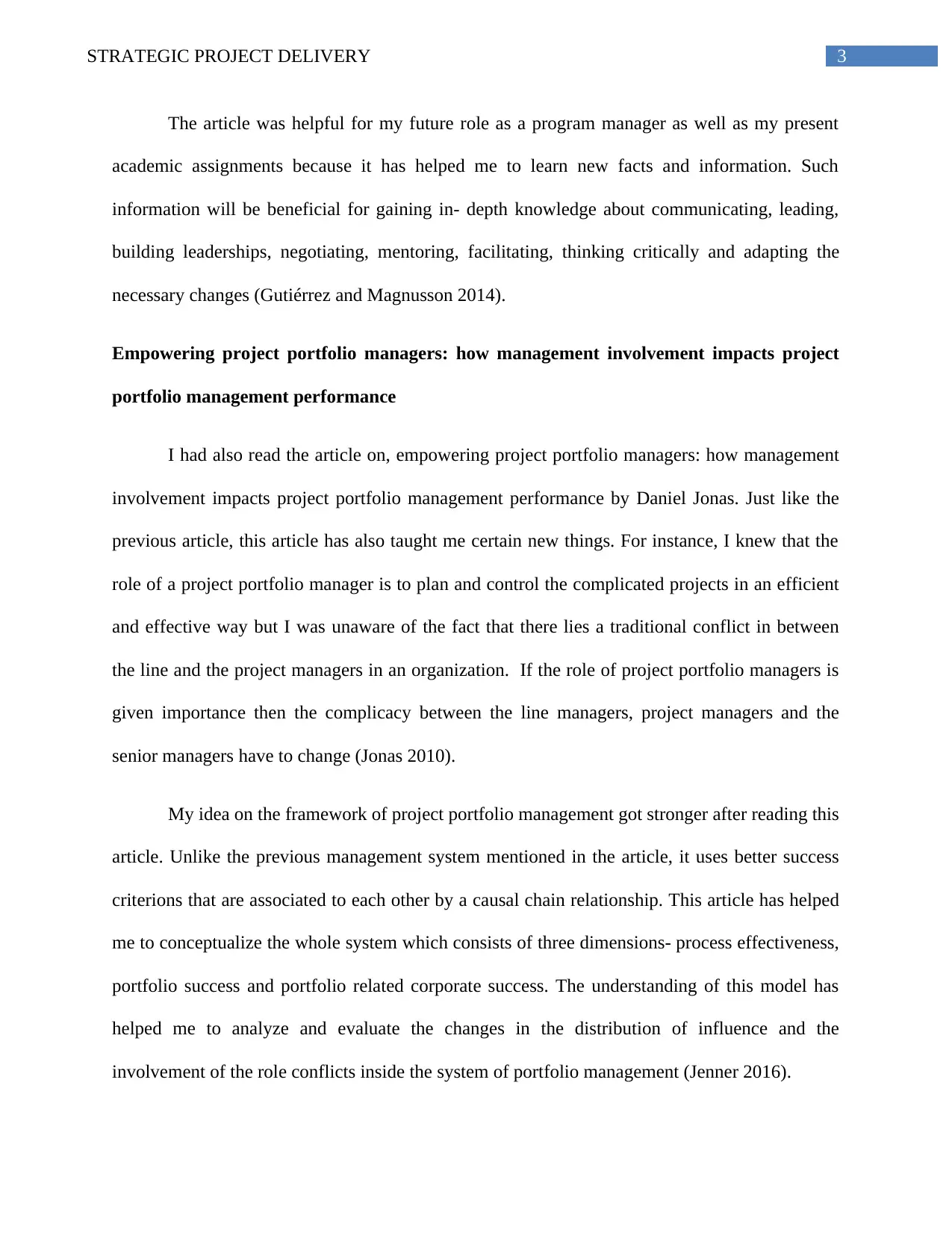
3STRATEGIC PROJECT DELIVERY
The article was helpful for my future role as a program manager as well as my present
academic assignments because it has helped me to learn new facts and information. Such
information will be beneficial for gaining in- depth knowledge about communicating, leading,
building leaderships, negotiating, mentoring, facilitating, thinking critically and adapting the
necessary changes (Gutiérrez and Magnusson 2014).
Empowering project portfolio managers: how management involvement impacts project
portfolio management performance
I had also read the article on, empowering project portfolio managers: how management
involvement impacts project portfolio management performance by Daniel Jonas. Just like the
previous article, this article has also taught me certain new things. For instance, I knew that the
role of a project portfolio manager is to plan and control the complicated projects in an efficient
and effective way but I was unaware of the fact that there lies a traditional conflict in between
the line and the project managers in an organization. If the role of project portfolio managers is
given importance then the complicacy between the line managers, project managers and the
senior managers have to change (Jonas 2010).
My idea on the framework of project portfolio management got stronger after reading this
article. Unlike the previous management system mentioned in the article, it uses better success
criterions that are associated to each other by a causal chain relationship. This article has helped
me to conceptualize the whole system which consists of three dimensions- process effectiveness,
portfolio success and portfolio related corporate success. The understanding of this model has
helped me to analyze and evaluate the changes in the distribution of influence and the
involvement of the role conflicts inside the system of portfolio management (Jenner 2016).
The article was helpful for my future role as a program manager as well as my present
academic assignments because it has helped me to learn new facts and information. Such
information will be beneficial for gaining in- depth knowledge about communicating, leading,
building leaderships, negotiating, mentoring, facilitating, thinking critically and adapting the
necessary changes (Gutiérrez and Magnusson 2014).
Empowering project portfolio managers: how management involvement impacts project
portfolio management performance
I had also read the article on, empowering project portfolio managers: how management
involvement impacts project portfolio management performance by Daniel Jonas. Just like the
previous article, this article has also taught me certain new things. For instance, I knew that the
role of a project portfolio manager is to plan and control the complicated projects in an efficient
and effective way but I was unaware of the fact that there lies a traditional conflict in between
the line and the project managers in an organization. If the role of project portfolio managers is
given importance then the complicacy between the line managers, project managers and the
senior managers have to change (Jonas 2010).
My idea on the framework of project portfolio management got stronger after reading this
article. Unlike the previous management system mentioned in the article, it uses better success
criterions that are associated to each other by a causal chain relationship. This article has helped
me to conceptualize the whole system which consists of three dimensions- process effectiveness,
portfolio success and portfolio related corporate success. The understanding of this model has
helped me to analyze and evaluate the changes in the distribution of influence and the
involvement of the role conflicts inside the system of portfolio management (Jenner 2016).
Paraphrase This Document
Need a fresh take? Get an instant paraphrase of this document with our AI Paraphraser
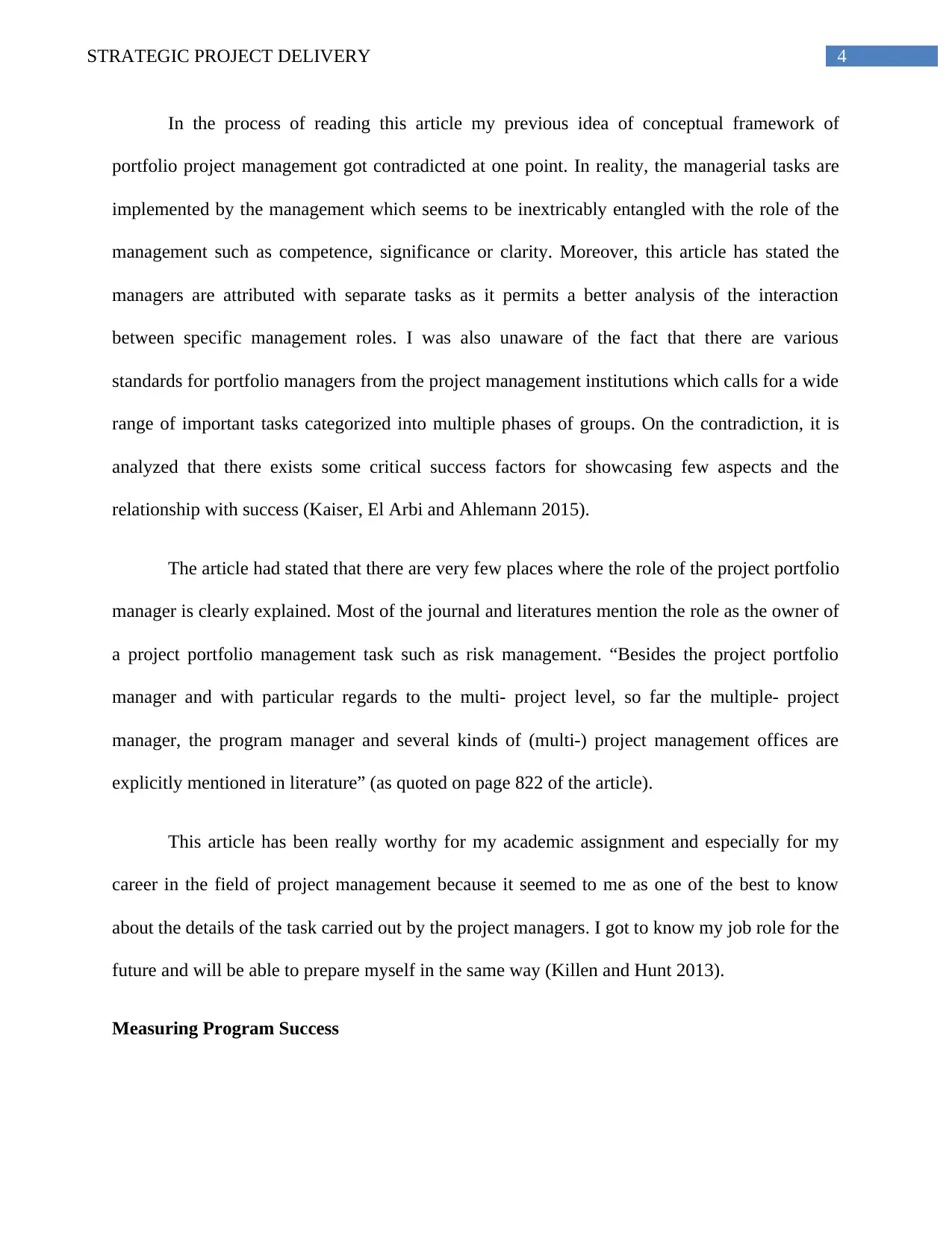
4STRATEGIC PROJECT DELIVERY
In the process of reading this article my previous idea of conceptual framework of
portfolio project management got contradicted at one point. In reality, the managerial tasks are
implemented by the management which seems to be inextricably entangled with the role of the
management such as competence, significance or clarity. Moreover, this article has stated the
managers are attributed with separate tasks as it permits a better analysis of the interaction
between specific management roles. I was also unaware of the fact that there are various
standards for portfolio managers from the project management institutions which calls for a wide
range of important tasks categorized into multiple phases of groups. On the contradiction, it is
analyzed that there exists some critical success factors for showcasing few aspects and the
relationship with success (Kaiser, El Arbi and Ahlemann 2015).
The article had stated that there are very few places where the role of the project portfolio
manager is clearly explained. Most of the journal and literatures mention the role as the owner of
a project portfolio management task such as risk management. “Besides the project portfolio
manager and with particular regards to the multi- project level, so far the multiple- project
manager, the program manager and several kinds of (multi-) project management offices are
explicitly mentioned in literature” (as quoted on page 822 of the article).
This article has been really worthy for my academic assignment and especially for my
career in the field of project management because it seemed to me as one of the best to know
about the details of the task carried out by the project managers. I got to know my job role for the
future and will be able to prepare myself in the same way (Killen and Hunt 2013).
Measuring Program Success
In the process of reading this article my previous idea of conceptual framework of
portfolio project management got contradicted at one point. In reality, the managerial tasks are
implemented by the management which seems to be inextricably entangled with the role of the
management such as competence, significance or clarity. Moreover, this article has stated the
managers are attributed with separate tasks as it permits a better analysis of the interaction
between specific management roles. I was also unaware of the fact that there are various
standards for portfolio managers from the project management institutions which calls for a wide
range of important tasks categorized into multiple phases of groups. On the contradiction, it is
analyzed that there exists some critical success factors for showcasing few aspects and the
relationship with success (Kaiser, El Arbi and Ahlemann 2015).
The article had stated that there are very few places where the role of the project portfolio
manager is clearly explained. Most of the journal and literatures mention the role as the owner of
a project portfolio management task such as risk management. “Besides the project portfolio
manager and with particular regards to the multi- project level, so far the multiple- project
manager, the program manager and several kinds of (multi-) project management offices are
explicitly mentioned in literature” (as quoted on page 822 of the article).
This article has been really worthy for my academic assignment and especially for my
career in the field of project management because it seemed to me as one of the best to know
about the details of the task carried out by the project managers. I got to know my job role for the
future and will be able to prepare myself in the same way (Killen and Hunt 2013).
Measuring Program Success
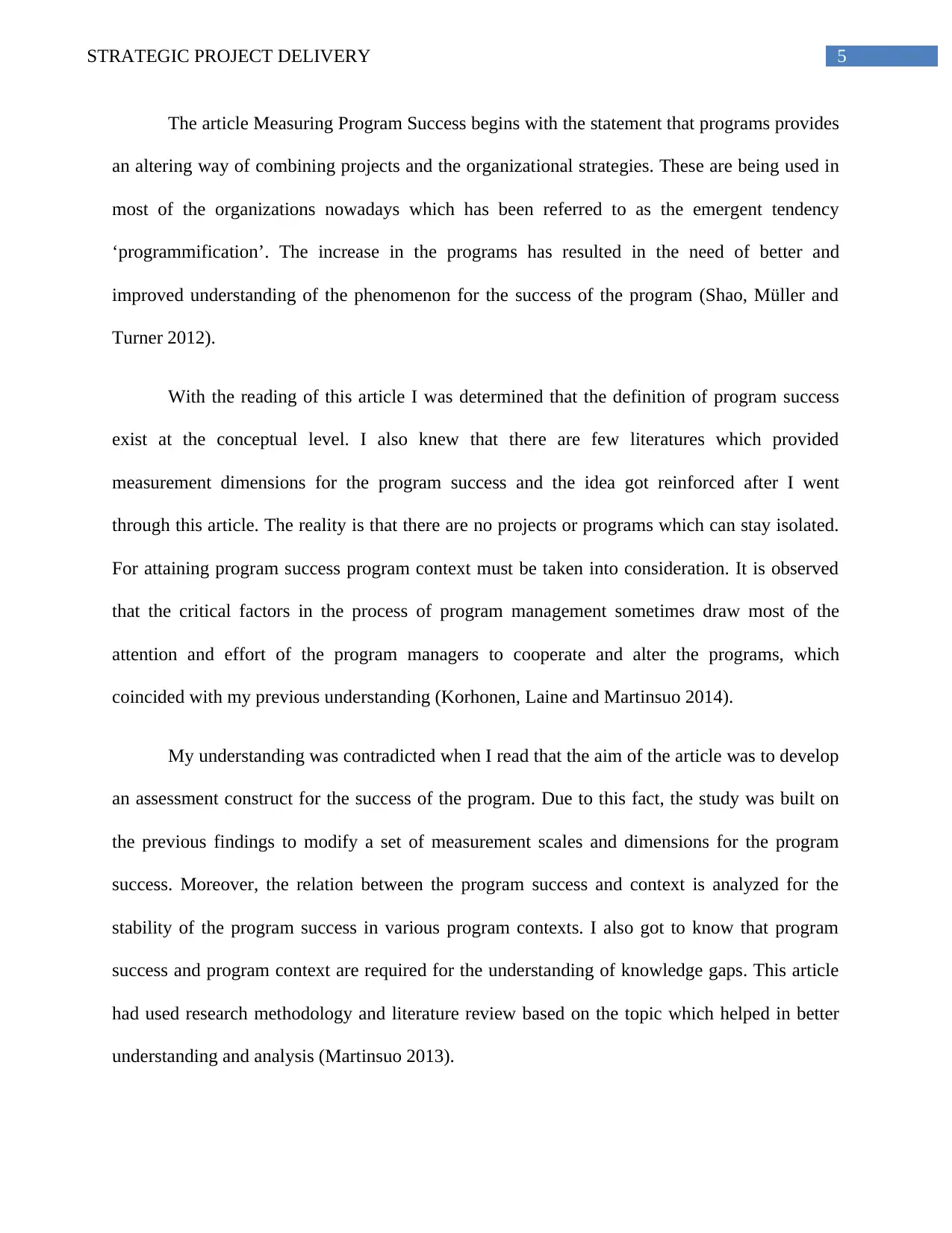
5STRATEGIC PROJECT DELIVERY
The article Measuring Program Success begins with the statement that programs provides
an altering way of combining projects and the organizational strategies. These are being used in
most of the organizations nowadays which has been referred to as the emergent tendency
‘programmification’. The increase in the programs has resulted in the need of better and
improved understanding of the phenomenon for the success of the program (Shao, Müller and
Turner 2012).
With the reading of this article I was determined that the definition of program success
exist at the conceptual level. I also knew that there are few literatures which provided
measurement dimensions for the program success and the idea got reinforced after I went
through this article. The reality is that there are no projects or programs which can stay isolated.
For attaining program success program context must be taken into consideration. It is observed
that the critical factors in the process of program management sometimes draw most of the
attention and effort of the program managers to cooperate and alter the programs, which
coincided with my previous understanding (Korhonen, Laine and Martinsuo 2014).
My understanding was contradicted when I read that the aim of the article was to develop
an assessment construct for the success of the program. Due to this fact, the study was built on
the previous findings to modify a set of measurement scales and dimensions for the program
success. Moreover, the relation between the program success and context is analyzed for the
stability of the program success in various program contexts. I also got to know that program
success and program context are required for the understanding of knowledge gaps. This article
had used research methodology and literature review based on the topic which helped in better
understanding and analysis (Martinsuo 2013).
The article Measuring Program Success begins with the statement that programs provides
an altering way of combining projects and the organizational strategies. These are being used in
most of the organizations nowadays which has been referred to as the emergent tendency
‘programmification’. The increase in the programs has resulted in the need of better and
improved understanding of the phenomenon for the success of the program (Shao, Müller and
Turner 2012).
With the reading of this article I was determined that the definition of program success
exist at the conceptual level. I also knew that there are few literatures which provided
measurement dimensions for the program success and the idea got reinforced after I went
through this article. The reality is that there are no projects or programs which can stay isolated.
For attaining program success program context must be taken into consideration. It is observed
that the critical factors in the process of program management sometimes draw most of the
attention and effort of the program managers to cooperate and alter the programs, which
coincided with my previous understanding (Korhonen, Laine and Martinsuo 2014).
My understanding was contradicted when I read that the aim of the article was to develop
an assessment construct for the success of the program. Due to this fact, the study was built on
the previous findings to modify a set of measurement scales and dimensions for the program
success. Moreover, the relation between the program success and context is analyzed for the
stability of the program success in various program contexts. I also got to know that program
success and program context are required for the understanding of knowledge gaps. This article
had used research methodology and literature review based on the topic which helped in better
understanding and analysis (Martinsuo 2013).
⊘ This is a preview!⊘
Do you want full access?
Subscribe today to unlock all pages.

Trusted by 1+ million students worldwide
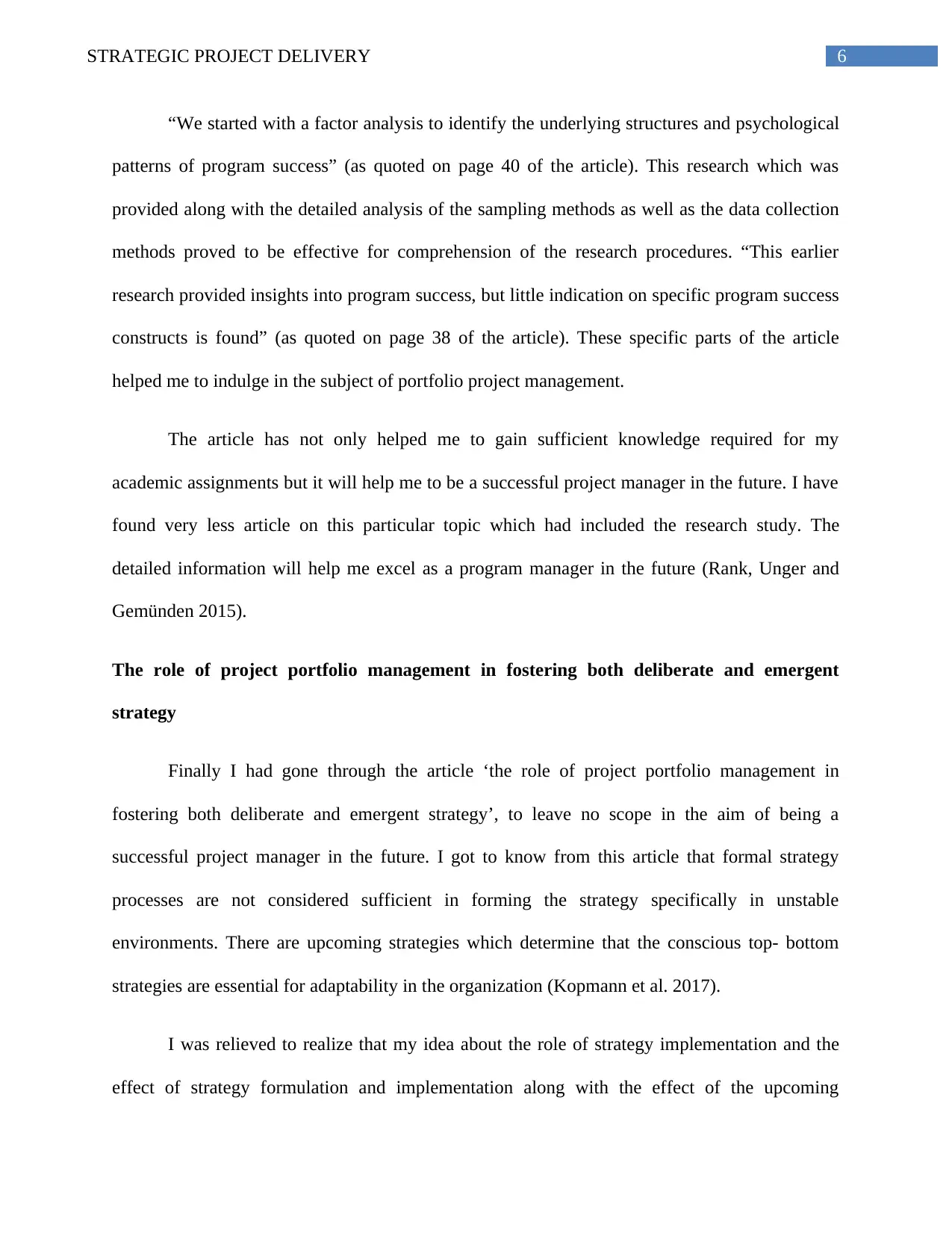
6STRATEGIC PROJECT DELIVERY
“We started with a factor analysis to identify the underlying structures and psychological
patterns of program success” (as quoted on page 40 of the article). This research which was
provided along with the detailed analysis of the sampling methods as well as the data collection
methods proved to be effective for comprehension of the research procedures. “This earlier
research provided insights into program success, but little indication on specific program success
constructs is found” (as quoted on page 38 of the article). These specific parts of the article
helped me to indulge in the subject of portfolio project management.
The article has not only helped me to gain sufficient knowledge required for my
academic assignments but it will help me to be a successful project manager in the future. I have
found very less article on this particular topic which had included the research study. The
detailed information will help me excel as a program manager in the future (Rank, Unger and
Gemünden 2015).
The role of project portfolio management in fostering both deliberate and emergent
strategy
Finally I had gone through the article ‘the role of project portfolio management in
fostering both deliberate and emergent strategy’, to leave no scope in the aim of being a
successful project manager in the future. I got to know from this article that formal strategy
processes are not considered sufficient in forming the strategy specifically in unstable
environments. There are upcoming strategies which determine that the conscious top- bottom
strategies are essential for adaptability in the organization (Kopmann et al. 2017).
I was relieved to realize that my idea about the role of strategy implementation and the
effect of strategy formulation and implementation along with the effect of the upcoming
“We started with a factor analysis to identify the underlying structures and psychological
patterns of program success” (as quoted on page 40 of the article). This research which was
provided along with the detailed analysis of the sampling methods as well as the data collection
methods proved to be effective for comprehension of the research procedures. “This earlier
research provided insights into program success, but little indication on specific program success
constructs is found” (as quoted on page 38 of the article). These specific parts of the article
helped me to indulge in the subject of portfolio project management.
The article has not only helped me to gain sufficient knowledge required for my
academic assignments but it will help me to be a successful project manager in the future. I have
found very less article on this particular topic which had included the research study. The
detailed information will help me excel as a program manager in the future (Rank, Unger and
Gemünden 2015).
The role of project portfolio management in fostering both deliberate and emergent
strategy
Finally I had gone through the article ‘the role of project portfolio management in
fostering both deliberate and emergent strategy’, to leave no scope in the aim of being a
successful project manager in the future. I got to know from this article that formal strategy
processes are not considered sufficient in forming the strategy specifically in unstable
environments. There are upcoming strategies which determine that the conscious top- bottom
strategies are essential for adaptability in the organization (Kopmann et al. 2017).
I was relieved to realize that my idea about the role of strategy implementation and the
effect of strategy formulation and implementation along with the effect of the upcoming
Paraphrase This Document
Need a fresh take? Get an instant paraphrase of this document with our AI Paraphraser
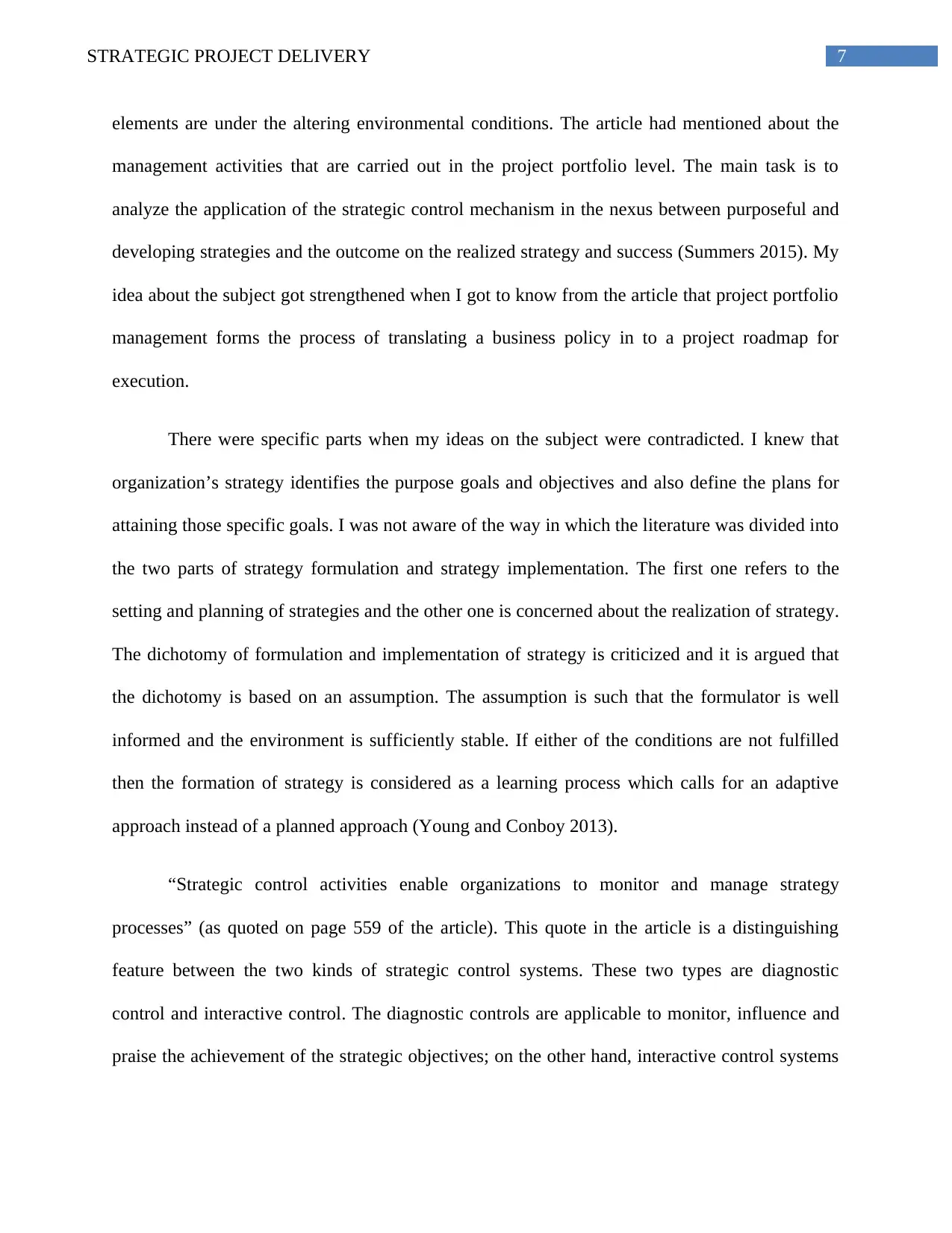
7STRATEGIC PROJECT DELIVERY
elements are under the altering environmental conditions. The article had mentioned about the
management activities that are carried out in the project portfolio level. The main task is to
analyze the application of the strategic control mechanism in the nexus between purposeful and
developing strategies and the outcome on the realized strategy and success (Summers 2015). My
idea about the subject got strengthened when I got to know from the article that project portfolio
management forms the process of translating a business policy in to a project roadmap for
execution.
There were specific parts when my ideas on the subject were contradicted. I knew that
organization’s strategy identifies the purpose goals and objectives and also define the plans for
attaining those specific goals. I was not aware of the way in which the literature was divided into
the two parts of strategy formulation and strategy implementation. The first one refers to the
setting and planning of strategies and the other one is concerned about the realization of strategy.
The dichotomy of formulation and implementation of strategy is criticized and it is argued that
the dichotomy is based on an assumption. The assumption is such that the formulator is well
informed and the environment is sufficiently stable. If either of the conditions are not fulfilled
then the formation of strategy is considered as a learning process which calls for an adaptive
approach instead of a planned approach (Young and Conboy 2013).
“Strategic control activities enable organizations to monitor and manage strategy
processes” (as quoted on page 559 of the article). This quote in the article is a distinguishing
feature between the two kinds of strategic control systems. These two types are diagnostic
control and interactive control. The diagnostic controls are applicable to monitor, influence and
praise the achievement of the strategic objectives; on the other hand, interactive control systems
elements are under the altering environmental conditions. The article had mentioned about the
management activities that are carried out in the project portfolio level. The main task is to
analyze the application of the strategic control mechanism in the nexus between purposeful and
developing strategies and the outcome on the realized strategy and success (Summers 2015). My
idea about the subject got strengthened when I got to know from the article that project portfolio
management forms the process of translating a business policy in to a project roadmap for
execution.
There were specific parts when my ideas on the subject were contradicted. I knew that
organization’s strategy identifies the purpose goals and objectives and also define the plans for
attaining those specific goals. I was not aware of the way in which the literature was divided into
the two parts of strategy formulation and strategy implementation. The first one refers to the
setting and planning of strategies and the other one is concerned about the realization of strategy.
The dichotomy of formulation and implementation of strategy is criticized and it is argued that
the dichotomy is based on an assumption. The assumption is such that the formulator is well
informed and the environment is sufficiently stable. If either of the conditions are not fulfilled
then the formation of strategy is considered as a learning process which calls for an adaptive
approach instead of a planned approach (Young and Conboy 2013).
“Strategic control activities enable organizations to monitor and manage strategy
processes” (as quoted on page 559 of the article). This quote in the article is a distinguishing
feature between the two kinds of strategic control systems. These two types are diagnostic
control and interactive control. The diagnostic controls are applicable to monitor, influence and
praise the achievement of the strategic objectives; on the other hand, interactive control systems
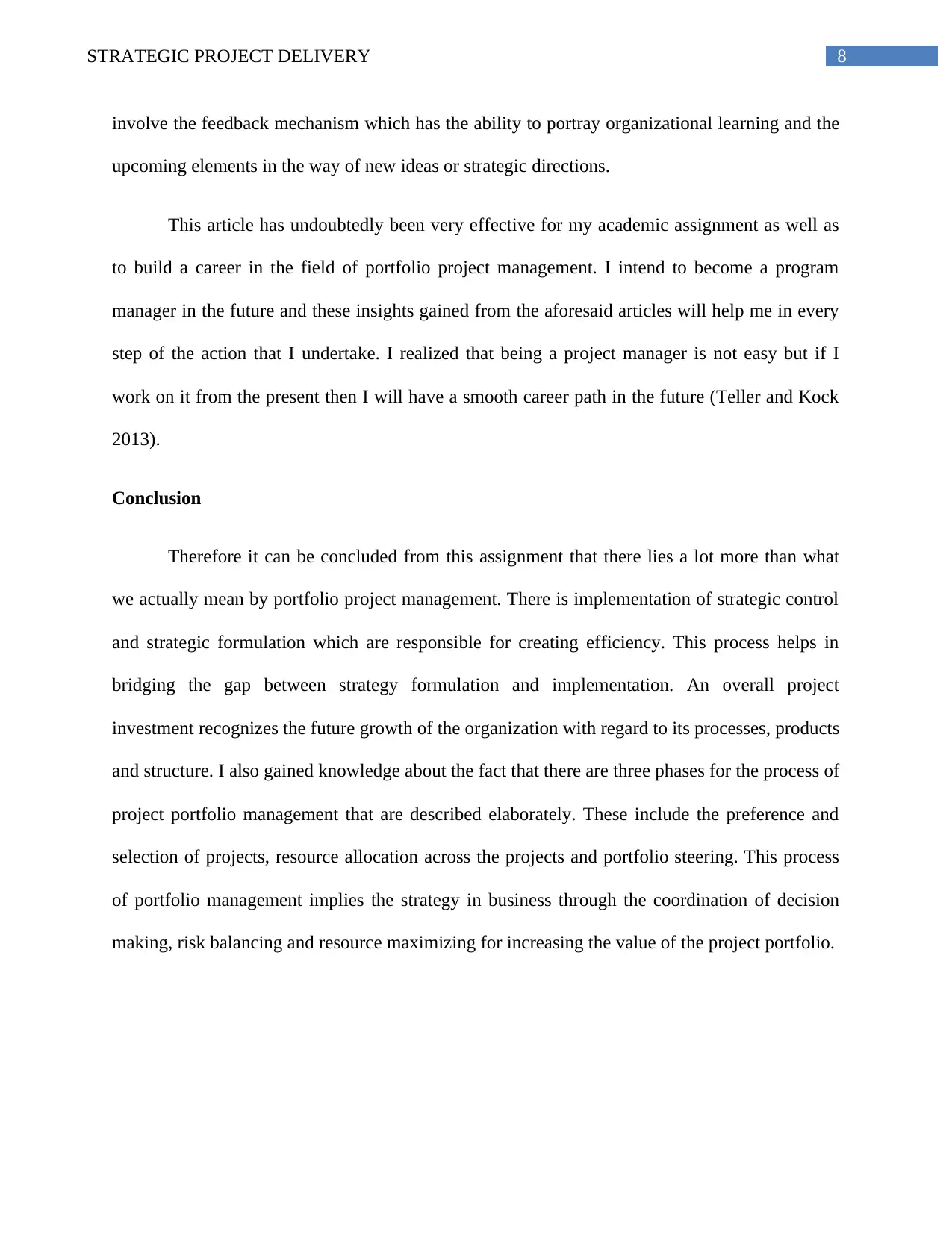
8STRATEGIC PROJECT DELIVERY
involve the feedback mechanism which has the ability to portray organizational learning and the
upcoming elements in the way of new ideas or strategic directions.
This article has undoubtedly been very effective for my academic assignment as well as
to build a career in the field of portfolio project management. I intend to become a program
manager in the future and these insights gained from the aforesaid articles will help me in every
step of the action that I undertake. I realized that being a project manager is not easy but if I
work on it from the present then I will have a smooth career path in the future (Teller and Kock
2013).
Conclusion
Therefore it can be concluded from this assignment that there lies a lot more than what
we actually mean by portfolio project management. There is implementation of strategic control
and strategic formulation which are responsible for creating efficiency. This process helps in
bridging the gap between strategy formulation and implementation. An overall project
investment recognizes the future growth of the organization with regard to its processes, products
and structure. I also gained knowledge about the fact that there are three phases for the process of
project portfolio management that are described elaborately. These include the preference and
selection of projects, resource allocation across the projects and portfolio steering. This process
of portfolio management implies the strategy in business through the coordination of decision
making, risk balancing and resource maximizing for increasing the value of the project portfolio.
involve the feedback mechanism which has the ability to portray organizational learning and the
upcoming elements in the way of new ideas or strategic directions.
This article has undoubtedly been very effective for my academic assignment as well as
to build a career in the field of portfolio project management. I intend to become a program
manager in the future and these insights gained from the aforesaid articles will help me in every
step of the action that I undertake. I realized that being a project manager is not easy but if I
work on it from the present then I will have a smooth career path in the future (Teller and Kock
2013).
Conclusion
Therefore it can be concluded from this assignment that there lies a lot more than what
we actually mean by portfolio project management. There is implementation of strategic control
and strategic formulation which are responsible for creating efficiency. This process helps in
bridging the gap between strategy formulation and implementation. An overall project
investment recognizes the future growth of the organization with regard to its processes, products
and structure. I also gained knowledge about the fact that there are three phases for the process of
project portfolio management that are described elaborately. These include the preference and
selection of projects, resource allocation across the projects and portfolio steering. This process
of portfolio management implies the strategy in business through the coordination of decision
making, risk balancing and resource maximizing for increasing the value of the project portfolio.
⊘ This is a preview!⊘
Do you want full access?
Subscribe today to unlock all pages.

Trusted by 1+ million students worldwide
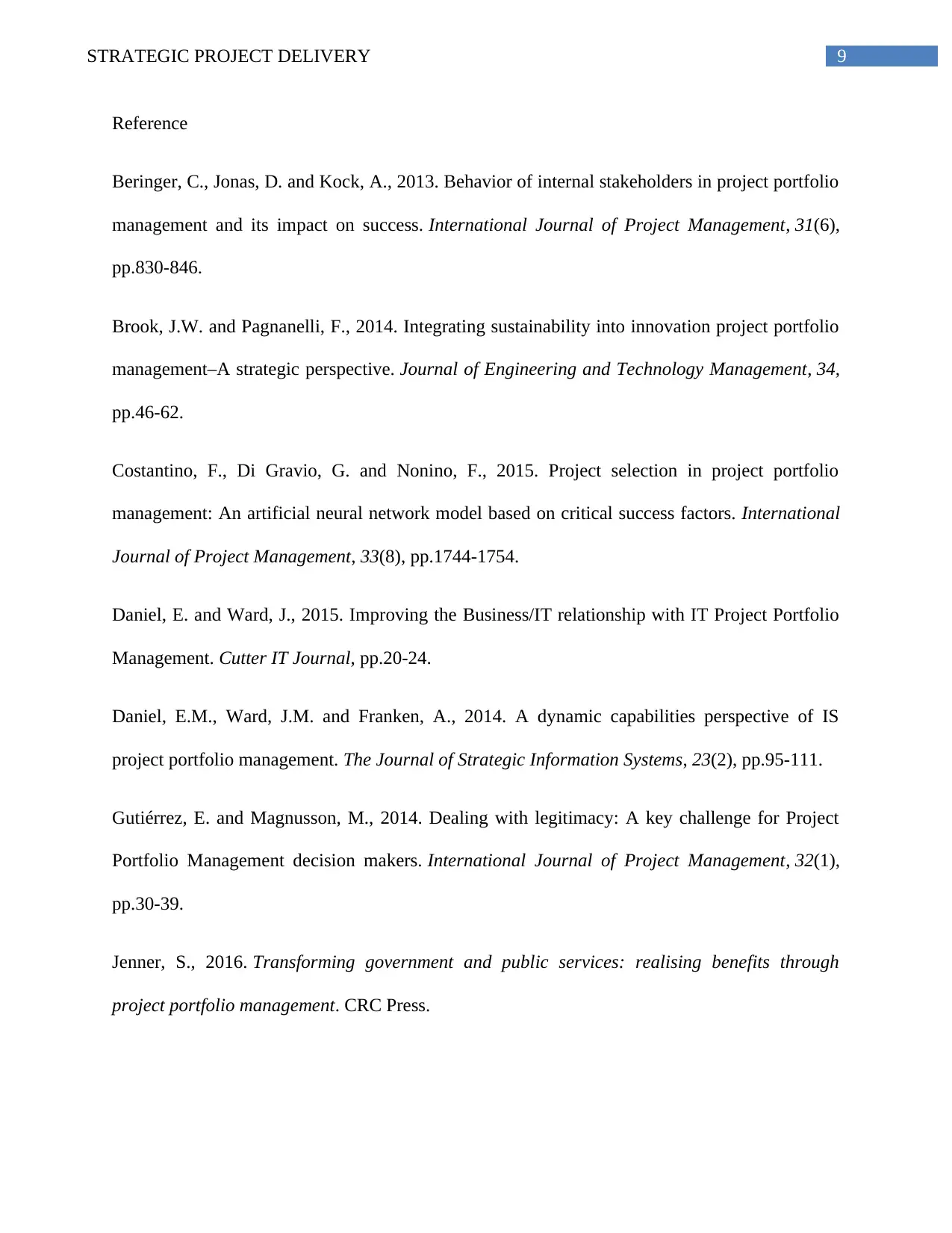
9STRATEGIC PROJECT DELIVERY
Reference
Beringer, C., Jonas, D. and Kock, A., 2013. Behavior of internal stakeholders in project portfolio
management and its impact on success. International Journal of Project Management, 31(6),
pp.830-846.
Brook, J.W. and Pagnanelli, F., 2014. Integrating sustainability into innovation project portfolio
management–A strategic perspective. Journal of Engineering and Technology Management, 34,
pp.46-62.
Costantino, F., Di Gravio, G. and Nonino, F., 2015. Project selection in project portfolio
management: An artificial neural network model based on critical success factors. International
Journal of Project Management, 33(8), pp.1744-1754.
Daniel, E. and Ward, J., 2015. Improving the Business/IT relationship with IT Project Portfolio
Management. Cutter IT Journal, pp.20-24.
Daniel, E.M., Ward, J.M. and Franken, A., 2014. A dynamic capabilities perspective of IS
project portfolio management. The Journal of Strategic Information Systems, 23(2), pp.95-111.
Gutiérrez, E. and Magnusson, M., 2014. Dealing with legitimacy: A key challenge for Project
Portfolio Management decision makers. International Journal of Project Management, 32(1),
pp.30-39.
Jenner, S., 2016. Transforming government and public services: realising benefits through
project portfolio management. CRC Press.
Reference
Beringer, C., Jonas, D. and Kock, A., 2013. Behavior of internal stakeholders in project portfolio
management and its impact on success. International Journal of Project Management, 31(6),
pp.830-846.
Brook, J.W. and Pagnanelli, F., 2014. Integrating sustainability into innovation project portfolio
management–A strategic perspective. Journal of Engineering and Technology Management, 34,
pp.46-62.
Costantino, F., Di Gravio, G. and Nonino, F., 2015. Project selection in project portfolio
management: An artificial neural network model based on critical success factors. International
Journal of Project Management, 33(8), pp.1744-1754.
Daniel, E. and Ward, J., 2015. Improving the Business/IT relationship with IT Project Portfolio
Management. Cutter IT Journal, pp.20-24.
Daniel, E.M., Ward, J.M. and Franken, A., 2014. A dynamic capabilities perspective of IS
project portfolio management. The Journal of Strategic Information Systems, 23(2), pp.95-111.
Gutiérrez, E. and Magnusson, M., 2014. Dealing with legitimacy: A key challenge for Project
Portfolio Management decision makers. International Journal of Project Management, 32(1),
pp.30-39.
Jenner, S., 2016. Transforming government and public services: realising benefits through
project portfolio management. CRC Press.
Paraphrase This Document
Need a fresh take? Get an instant paraphrase of this document with our AI Paraphraser
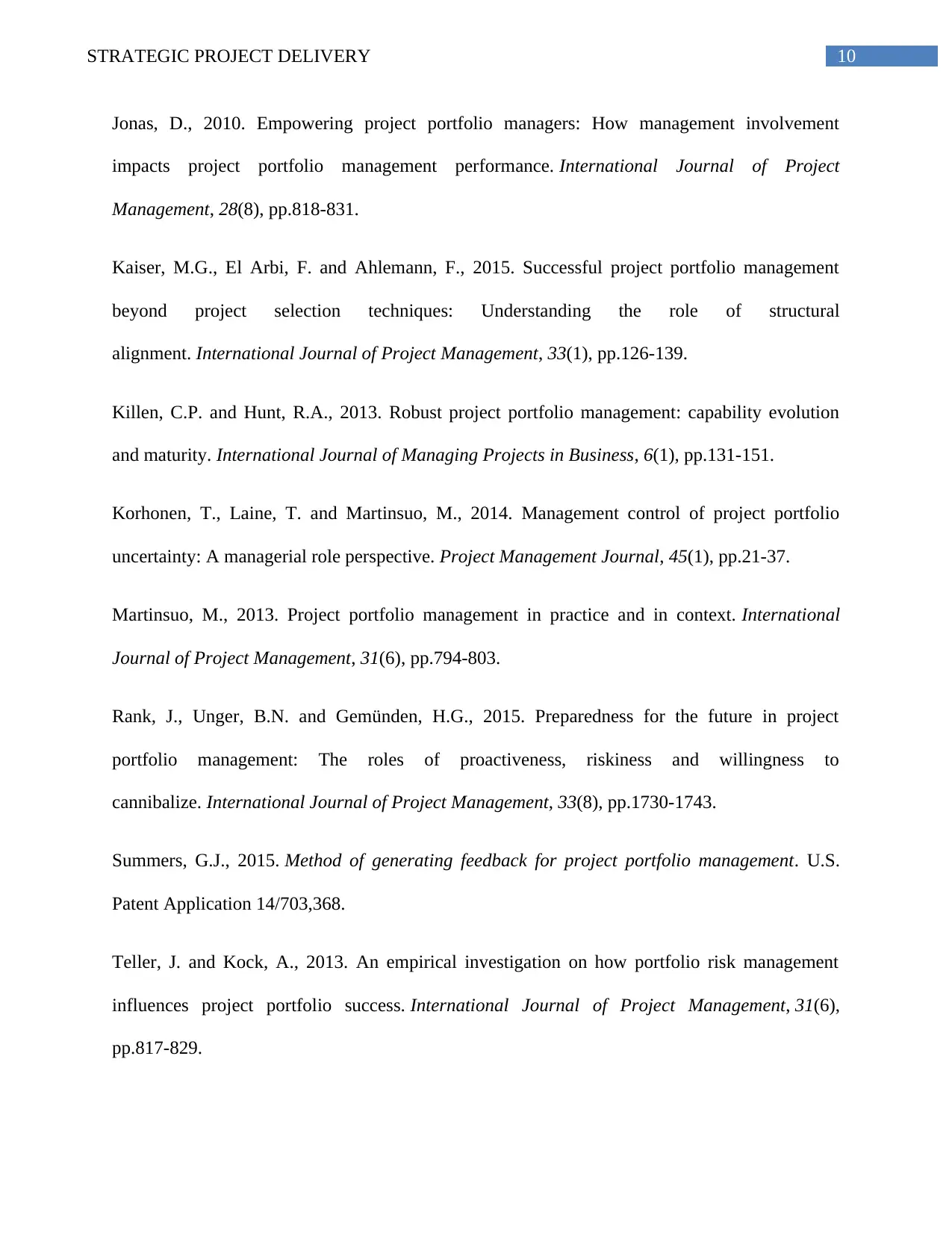
10STRATEGIC PROJECT DELIVERY
Jonas, D., 2010. Empowering project portfolio managers: How management involvement
impacts project portfolio management performance. International Journal of Project
Management, 28(8), pp.818-831.
Kaiser, M.G., El Arbi, F. and Ahlemann, F., 2015. Successful project portfolio management
beyond project selection techniques: Understanding the role of structural
alignment. International Journal of Project Management, 33(1), pp.126-139.
Killen, C.P. and Hunt, R.A., 2013. Robust project portfolio management: capability evolution
and maturity. International Journal of Managing Projects in Business, 6(1), pp.131-151.
Korhonen, T., Laine, T. and Martinsuo, M., 2014. Management control of project portfolio
uncertainty: A managerial role perspective. Project Management Journal, 45(1), pp.21-37.
Martinsuo, M., 2013. Project portfolio management in practice and in context. International
Journal of Project Management, 31(6), pp.794-803.
Rank, J., Unger, B.N. and Gemünden, H.G., 2015. Preparedness for the future in project
portfolio management: The roles of proactiveness, riskiness and willingness to
cannibalize. International Journal of Project Management, 33(8), pp.1730-1743.
Summers, G.J., 2015. Method of generating feedback for project portfolio management. U.S.
Patent Application 14/703,368.
Teller, J. and Kock, A., 2013. An empirical investigation on how portfolio risk management
influences project portfolio success. International Journal of Project Management, 31(6),
pp.817-829.
Jonas, D., 2010. Empowering project portfolio managers: How management involvement
impacts project portfolio management performance. International Journal of Project
Management, 28(8), pp.818-831.
Kaiser, M.G., El Arbi, F. and Ahlemann, F., 2015. Successful project portfolio management
beyond project selection techniques: Understanding the role of structural
alignment. International Journal of Project Management, 33(1), pp.126-139.
Killen, C.P. and Hunt, R.A., 2013. Robust project portfolio management: capability evolution
and maturity. International Journal of Managing Projects in Business, 6(1), pp.131-151.
Korhonen, T., Laine, T. and Martinsuo, M., 2014. Management control of project portfolio
uncertainty: A managerial role perspective. Project Management Journal, 45(1), pp.21-37.
Martinsuo, M., 2013. Project portfolio management in practice and in context. International
Journal of Project Management, 31(6), pp.794-803.
Rank, J., Unger, B.N. and Gemünden, H.G., 2015. Preparedness for the future in project
portfolio management: The roles of proactiveness, riskiness and willingness to
cannibalize. International Journal of Project Management, 33(8), pp.1730-1743.
Summers, G.J., 2015. Method of generating feedback for project portfolio management. U.S.
Patent Application 14/703,368.
Teller, J. and Kock, A., 2013. An empirical investigation on how portfolio risk management
influences project portfolio success. International Journal of Project Management, 31(6),
pp.817-829.
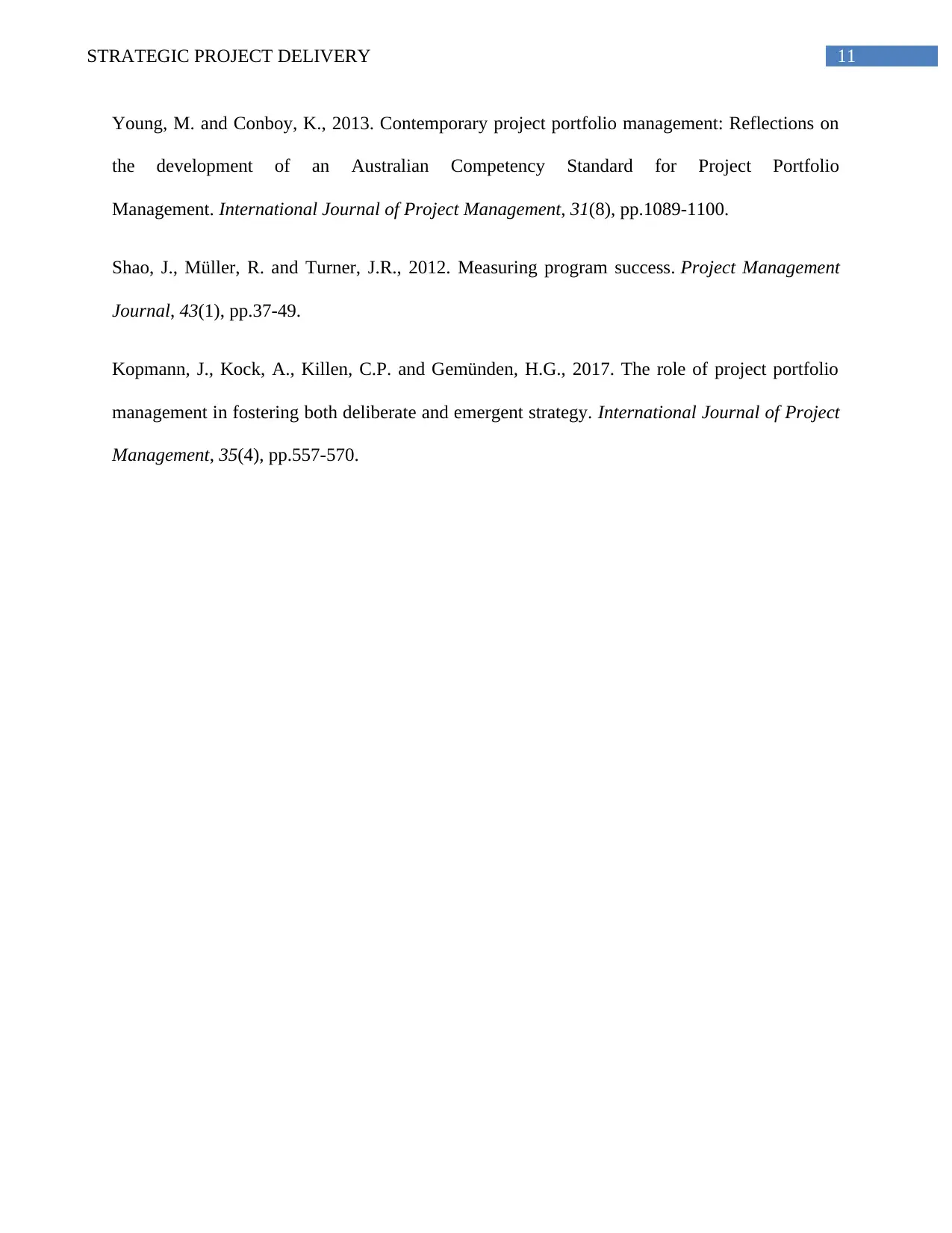
11STRATEGIC PROJECT DELIVERY
Young, M. and Conboy, K., 2013. Contemporary project portfolio management: Reflections on
the development of an Australian Competency Standard for Project Portfolio
Management. International Journal of Project Management, 31(8), pp.1089-1100.
Shao, J., Müller, R. and Turner, J.R., 2012. Measuring program success. Project Management
Journal, 43(1), pp.37-49.
Kopmann, J., Kock, A., Killen, C.P. and Gemünden, H.G., 2017. The role of project portfolio
management in fostering both deliberate and emergent strategy. International Journal of Project
Management, 35(4), pp.557-570.
Young, M. and Conboy, K., 2013. Contemporary project portfolio management: Reflections on
the development of an Australian Competency Standard for Project Portfolio
Management. International Journal of Project Management, 31(8), pp.1089-1100.
Shao, J., Müller, R. and Turner, J.R., 2012. Measuring program success. Project Management
Journal, 43(1), pp.37-49.
Kopmann, J., Kock, A., Killen, C.P. and Gemünden, H.G., 2017. The role of project portfolio
management in fostering both deliberate and emergent strategy. International Journal of Project
Management, 35(4), pp.557-570.
⊘ This is a preview!⊘
Do you want full access?
Subscribe today to unlock all pages.

Trusted by 1+ million students worldwide
1 out of 12
Related Documents
Your All-in-One AI-Powered Toolkit for Academic Success.
+13062052269
info@desklib.com
Available 24*7 on WhatsApp / Email
![[object Object]](/_next/static/media/star-bottom.7253800d.svg)
Unlock your academic potential
Copyright © 2020–2025 A2Z Services. All Rights Reserved. Developed and managed by ZUCOL.





